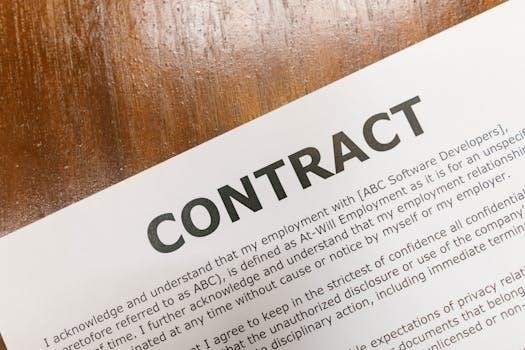What is a Termination of Employment Letter?
A termination of employment letter, often found as a PDF document, is a formal notification to an employee that their job is ending. This document outlines the reasons for and date of termination.
This letter is also called an employee termination form, employment termination form, a letter to fire an employee, a pink slip, or a separation notice, all serving the same purpose.
Definition and Purpose of the Letter
A termination of employment letter, frequently encountered as a PDF document, serves as a formal written notification from an employer to an employee, explicitly stating that their employment with the company is coming to an end. This crucial document meticulously outlines the specific reasons for the termination, ensuring transparency and legal compliance, and includes the effective date of the termination, marking the last day of employment. The primary purpose of this letter is to clearly communicate the employer’s decision, provide a formal record of the termination, and to initiate the necessary procedures for the employee’s departure. It’s a vital tool for managing the end of an employment relationship, ensuring both the employee and employer are aware of their rights and obligations during the separation process, and helps avoid any misunderstandings.
Alternative Names for the Document
The termination of employment letter, often saved as a PDF for easy access and distribution, is known by various names across different organizations and regions. These alternative names, while differing in wording, all refer to the same critical document that formally ends an employment relationship. You might hear it called an employee termination form, emphasizing its function as a formal record. It’s also sometimes referred to as an employment termination form, highlighting its role in ending the employment agreement. In less formal contexts, it can be known as a letter to fire an employee, which clearly states its purpose. Furthermore, the terms pink slip or separation notice are also widely used, indicating that the employee is being released from their position. Regardless of the specific name used, all these terms point to the same crucial document.
Key Components of a Termination Letter
A termination letter must include the employee’s name, date of termination, reasons for termination, and any severance or benefits information clearly stated.
Essential Information to Include
A crucial element of any termination of employment letter, especially one formatted as a PDF, is the inclusion of essential details. This encompasses the full legal name of the employee, ensuring no ambiguity in identification. The precise date of termination must be clearly stated, leaving no room for misinterpretation. Furthermore, a concise explanation of the reason for termination is necessary, adhering to legal guidelines and company policy. Any details regarding severance pay, benefits continuation, or the final paycheck should be explicitly outlined. The letter should also specify the return of any company property, such as laptops or identification badges. Lastly, contact information for relevant departments should be provided for any follow-up questions the employee may have concerning the process. The letter must be written in clear and understandable language, avoiding any form of jargon that may confuse the individual. This precise information ensures the terminated employee fully understands their rights and obligations as they transition from the company.
Importance of Clarity and Precision
Clarity and precision are paramount in a termination of employment letter, especially when formalized as a PDF, due to its legal and formal implications. Ambiguity can lead to misunderstandings, disputes, and even legal challenges. Clear language ensures that the employee fully comprehends the reasons for their termination, their final pay, and any benefits they might receive. Precise wording avoids any misinterpretations about the terms of separation, such as the date of their final employment and the return of company property. This precision also protects the employer from potential legal issues, as a well-written letter serves as an accurate record of the termination process. The use of clear and concise language helps to maintain a professional tone and reduces the emotional burden of the situation. Furthermore, it demonstrates the employer’s commitment to fairness and transparency during a difficult process. Ultimately, a clear and precise letter helps ensure a smoother and less contentious termination process for all involved.

Types of Termination Letters
This letter is used when an employee is terminated due to misconduct or poor performance, detailing the specific reasons for the action.
Termination Without Cause (Staff Reduction)
This type of letter informs an employee that their position is being eliminated due to restructuring or financial reasons, with no fault of their own.
Termination with Cause
A termination with cause letter is utilized when an employee’s actions, behavior, or performance fall short of the required standards, necessitating the end of their employment. This type of termination arises from specific unacceptable conduct, poor job performance, or violations of company policies that warrant immediate action. The letter must clearly outline the exact reasons for the termination, providing concrete examples of the employee’s unacceptable behavior or poor performance. This ensures transparency and protects the employer from potential legal challenges. The document should specify the specific policy or standard that was violated, and include any relevant dates or times of the incidents. It’s a critical step to ensure the termination process is legally sound and fair.
Termination Without Cause (Staff Reduction)
A termination without cause, often due to staff reduction or restructuring, occurs when an employee’s role is eliminated not due to any fault on their part. This type of termination is typically a result of economic downturns, company reorganizations, or changes in business strategy. The termination letter in this scenario should clearly state that the employee’s position is being eliminated and that the termination is not a reflection of their performance. It is important to emphasize that this action is not related to their actions or behavior. The letter must include information regarding the severance package, any benefits continuation, and the last day of employment. Employers should act with empathy and provide support during this transition, as this is a difficult time for affected employees.

Writing a Termination Letter
Begin with the letterhead, including the date and employer’s details. Clearly state the termination, reasons, and last day of employment. Provide details about benefits and pay.
Utilizing a termination letter template can help ensure that all crucial information is included, maintaining consistency and saving time during the drafting process.
Step-by-Step Guide to Drafting
Drafting a termination of employment letter, especially in PDF format, requires careful attention to detail; Start by including a clear letterhead with the date, company name, and address. Begin the letter with a formal salutation, addressing the employee by name. Explicitly state that their employment is being terminated and specify the effective date. Provide a concise and factual explanation for the termination, whether it’s for cause or due to a staff reduction. Include details regarding the final paycheck, any accrued vacation time, and information about benefits continuation, such as health insurance or retirement plans. Be sure to mention any severance pay that the employee might be entitled to. Clearly outline the next steps and procedures the employee should follow. Conclude with a professional closing and a signature by an authorized representative of the company. Ensure that the letter maintains a professional and respectful tone throughout. Remember that this document serves as both a formal notification and a record of the termination, making accuracy and clarity paramount, and double checking is a MUST.
Using a Template for Efficiency
Utilizing a termination of employment letter template, especially in PDF format, can significantly streamline the process. Templates offer a pre-structured format, ensuring all essential information is included, such as the employee’s details, termination date, and reasons. This saves time and reduces the risk of overlooking crucial elements, promoting consistency across all termination letters. A template provides a standardized approach to delivering bad news. These ready-made formats also guide employers in using professional and legally sound language. They can be customized to fit specific situations, whether for termination with cause or without. Templates serve as a starting point, allowing for personalization while ensuring necessary components are not missed. This efficiency is particularly helpful when managing multiple terminations or when a quick turnaround is needed. It also reduces the likelihood of errors and ensures that every termination is handled consistently and professionally, which is paramount when dealing with sensitive situations in an office enviroment.

Delivery and Follow-up
After preparing the termination of employment letter, a meeting with the employee is essential to explain the reasons and answer questions with clarity and care.
Alongside the letter, offering a separation agreement ensures the employee understands their rights, severance, and any other relevant details related to their departure.
Meeting with the Employee
Once the termination of employment letter is prepared, a crucial step involves scheduling a meeting with the affected employee. This meeting serves as a formal opportunity to deliver the termination notice in person, allowing for direct communication and a chance for the employee to understand the situation fully. During this meeting, it’s important to carefully explain the reasons for the termination, ensuring transparency and clarity. The employee should be given ample opportunity to ask questions and seek clarification on any aspects of the termination process. This face-to-face interaction provides a more humane approach to delivering difficult news, allowing the employee to express any concerns or ask for additional information regarding their final pay, benefits, and other logistical details. It also allows the employer to ensure the employee receives and acknowledges the termination letter. The meeting should be conducted with empathy and professionalism.
Providing a Separation Agreement
Following the delivery of the termination of employment letter and the meeting with the employee, providing a formal separation agreement is a critical step. This document details the employee’s rights, outlining severance pay, benefits continuation, and any other compensation they are entitled to upon termination. This agreement also specifies the terms of any confidentiality or non-compete clauses that might apply; The separation agreement should be carefully drafted to ensure clarity and legal compliance, providing a clear understanding of the expectations and obligations of both parties. It should be reviewed with the employee, allowing them to seek legal counsel before signing, ensuring they understand the terms. This agreement is essential for protecting both the employee and the employer by providing a formal record of the terms of their separation.

Legal Considerations
Employers must provide written notice of termination, specifying the end date. This is crucial for legal compliance and to protect both parties involved.
Employees have rights regarding severance, benefits, and other compensation. These must be clearly outlined in the termination process and separation agreement.
Importance of Written Notice
Providing a written notice of termination is paramount as it serves as a formal record of the employer’s decision to end the employment relationship. This document, often delivered in PDF format for easy sharing, is not just a formality but a legally significant step that ensures both the employer and employee are aware of the termination date and terms. It protects the employer by providing documented evidence of notification, which can be essential in case of disputes or legal challenges. Furthermore, it supports transparency, allowing the employee to understand the decision, their last day of work, and any related arrangements. This is critical for maintaining a professional and legally sound termination process, adhering to labor laws that often mandate written notice for employment cessation.
Employee Rights and Severance
When an employee is terminated, particularly as documented in a termination of employment letter PDF, understanding their rights is crucial. These rights often include the entitlement to severance pay, which varies based on employment contracts, company policies, and local laws. Severance is not always guaranteed, but it is a key consideration in many terminations, particularly when the termination is without cause due to staff reduction. Furthermore, employees may have rights related to continued health benefits through COBRA, and unused vacation time. The termination letter should clearly outline these entitlements. Additionally, employees should have the opportunity to ask questions regarding their rights and benefits. The letter must be clear to ensure no misunderstanding of their entitlements and avoid potential legal issues.